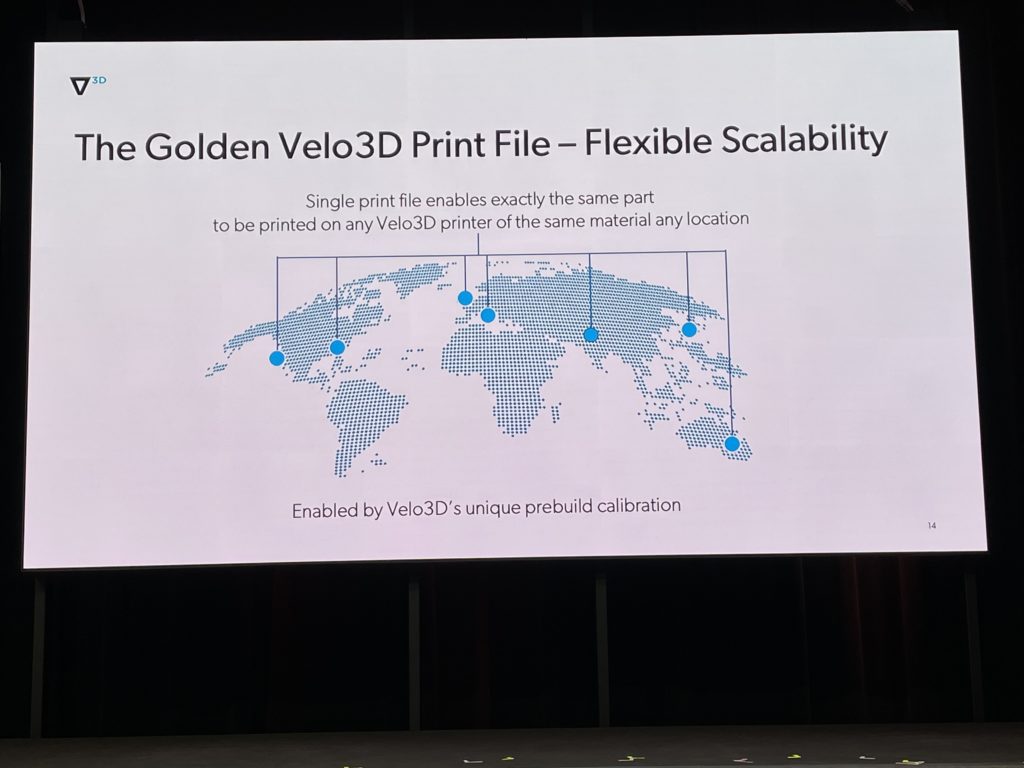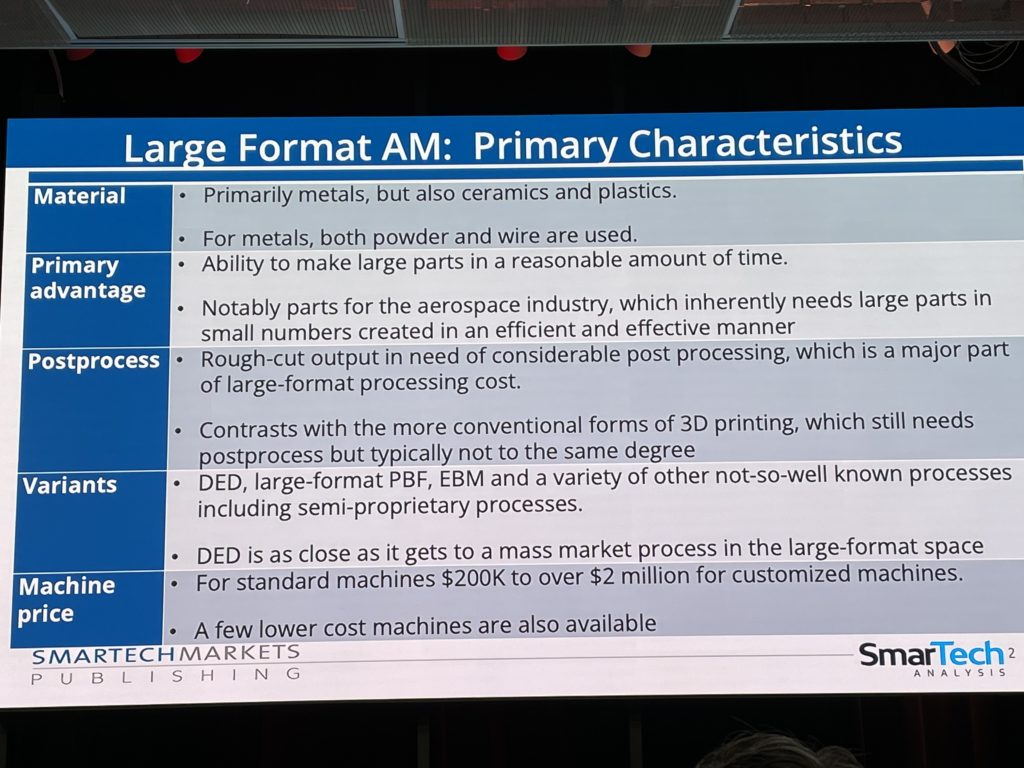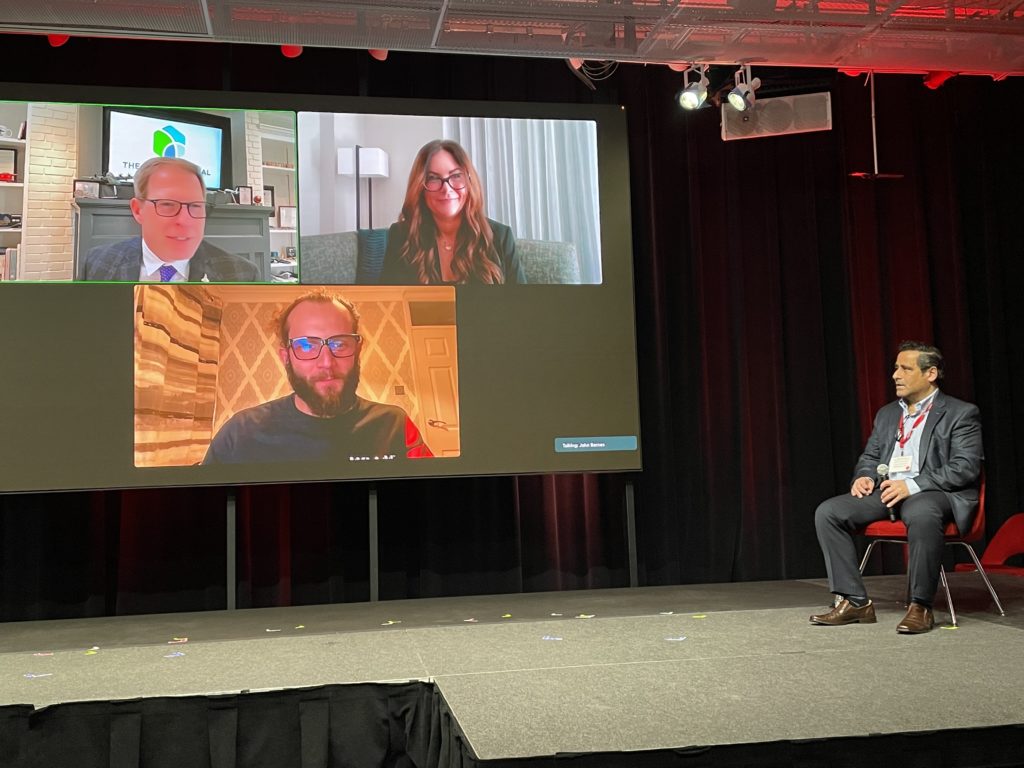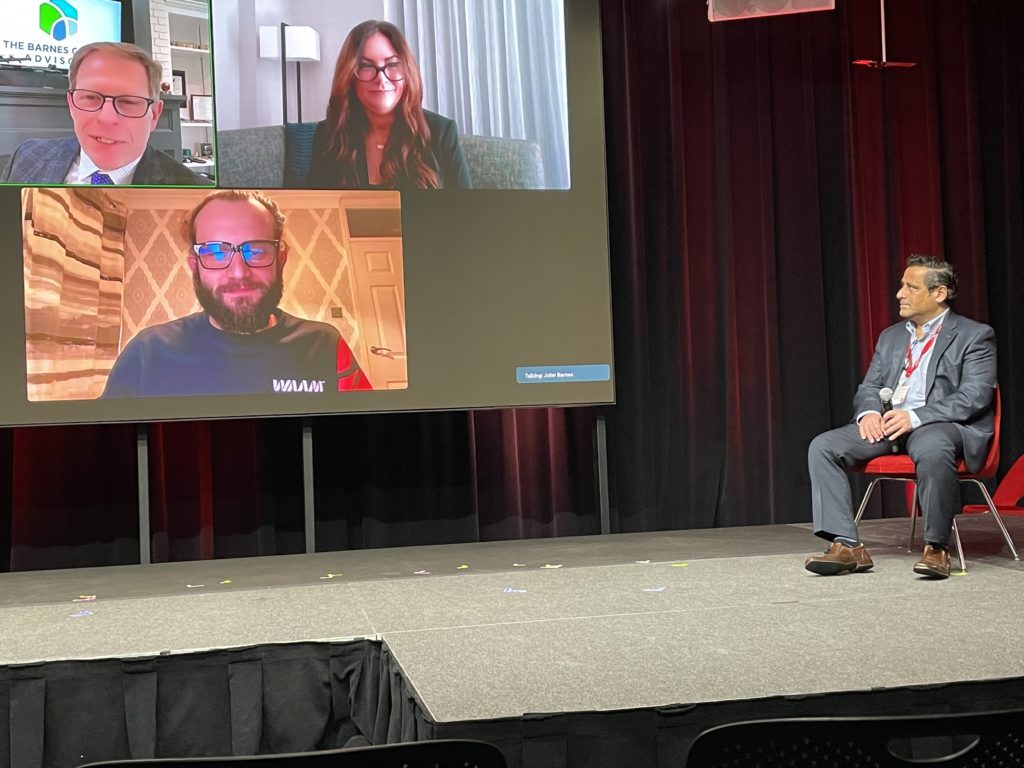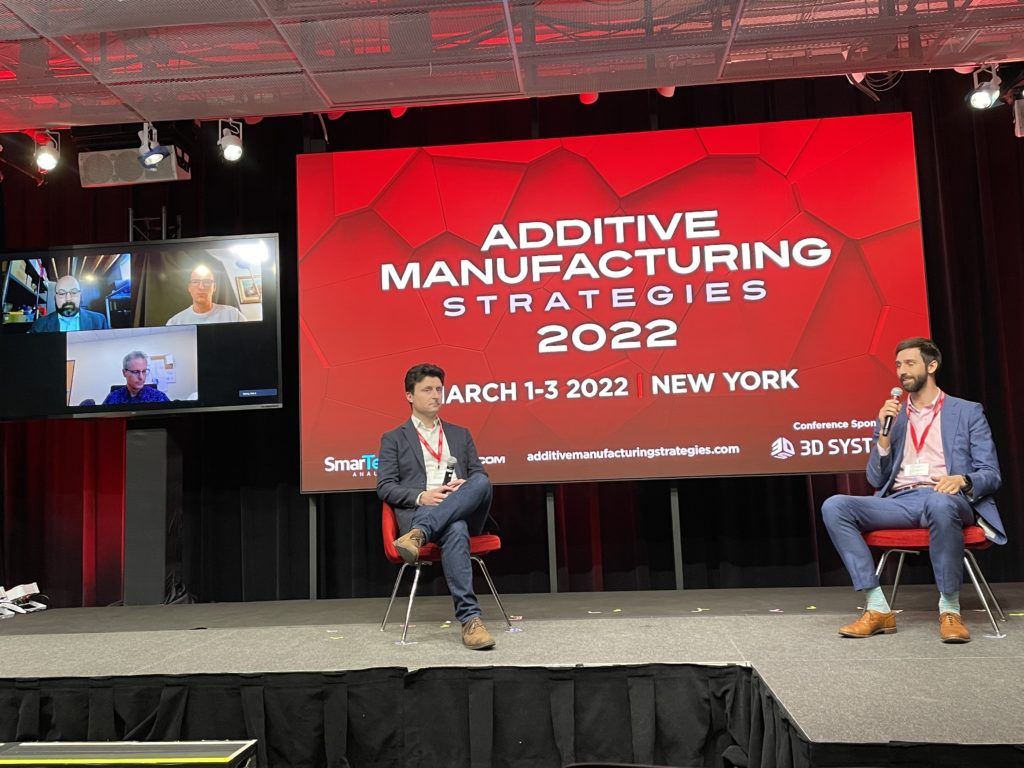In part one of my coverage of metal 3D printing at Additive Manufacturing Strategies 2022, I discussed the first session of the day, Additive Manufacturing for Series Production of Metal Parts. Here, I’ll take you through the experience of session two, Industrial Metal Additive Manufacturing.
Session 2: Industrial Metal Additive Manufacturing
VELO3D Topic Keynote
The second track of the day kicked off with a keynote presentation by Zach Murphree, Vice President of Global Sales and Business Development, VELO3D, who said that metal AM is “mainly focused around laser powder bed fusion,” which is a widely accepted additive technology in many industries and helps “drive this technology to be very industrial.”
“At its root, metal additive manufacturing is industrial, almost out of necessity,” he said, noting the higher costs and amount of post-processing. “You need a good justification to use it.”
Industries that have found the justification include space and defense, medical, commercial aviation, and heavy industry. Murphree said that scalability, consistency, and application fit are the main things that slow down further adoption of metal AM. Geometric capability, size, and materials are the main considerations for application fit, all of which Velo3D works to offer.
He explained that it’s difficult to verify if a large part is good or not, “and a lot of that comes down to verifiable consistency, which is the key enabler.” Murphree then moved on to say that parameters are “almost a religious debate” when it comes to LPBF technology, as some users are gung-ho for open architectures and others are just as insistent on closed.
“What we’re advocating is controlled parameters,” Murphree said about Velo3D. “You need to know exactly what’s going on in the process you’re performing…it takes a lot of testing, there’s a lot of variability to account for.”
He said that some OEMs have made it here, but only through “expensive, individual effort.” Design levels are needed to keep things more accessible.
Murphree wrapped things up by explaining that scalability is the last step needed to move towards the projections for the metal AM industry, by building software and execution. To achieve this, a single build file is key, which will save time and money in the long run because the files won’t need to be tuned each time a new machine, material, or vendor is used.
Market Forecast for Large-Format AM
Moving on, SmarTech Analysis President Lawrence Gasman presented the Market Forecast for Large-Format AM, which he says is a “measure of how fast metal additive is growing in general.”
“What do we really mean when we say large-format? For our purposes, for forecast, we’re talking about a print volume at or larger than one cubic meter,” he explained. “Large-format covers a multitude of sins, all the way up to room-sized ventures.”
Gasman said that while people have unique names for large-format metal additive, “they’re usually variations on things that already exist,” such as DED (the largest segment in the market) and WAAM. He noted that with subtractive technologies, it can take months to create a large-format part, but additive manufacturing can create it in one month, which is, economically speaking, pretty successful.
He mentioned that wire AM is fairly close to welding in terms of process, and also that, as reflected in the below slide, North America is the largest area by far for large-format metal 3D printer installation.
Gasman explained that the numbers are much smaller for large-format non-metal printers.
“It occurred to me that the whole sector of large-format machines, at least the industry that produces them, is a very big example of competition,” he said. “It’s not a real competition, you can differentiate yourself a bit and set your own prices, but you can’t really control the price. So what it ends up being is a lot of small to medium firms producing things.”
He finished up by listing some of the applications for large-format 3D printing, including aerospace, marine, and construction, and also noted that service bureaus also purchase big 3D printing systems as well.
The Future of DED and WAAM
John Barnes, the Managing Director of The Barnes Global Advisors and Adjunct Professor at both Carnegie Mellon University and Royal Melbourne Institute of Technology, virtually moderated the next panel, about the Future of DED and WAAM. Panelists Melanie Lang, the Co-Founder and CEO of FormAlloy, and Filomeno Martina, CEO and Co-Founder, WAAM3D, joined virtually as well, while Optomec CEO David Ramahi was in-person.
Touching on the SmarTech numbers, Barnes said that DED has existed longer than the other metal AM processes and “enjoyed success early on,” as many of these companies “are actually profitable.” He said DED is meant for large parts, which can be difficult to understand if “you don’t understand small,” and asked Lang how FormAlloy got through this.
“You do have to look at your specific application and decide what technology is best for you,” she answered. “As you go large, DED might be a good solution, but for small parts with complex shapes and good surface finish, you may choose a hybrid technology or a different additive method. Some of the progress I’ve seen is the willingness to look at the entire ecosystem of additive and be open. DED, whether it’s for builds or repair or enhancing, it’s still just one tool in the toolbox, it’s not one-size-fits-all.”
Barnes asked Ramahi if the repair market was overlooked, and he answered that it’s a great application for Optomec, with many of its machines used for repairing aircraft parts.
“When some people are dismissive of repair as an application, they’re missing the opportunity,” Ramahi continued. “These are really large markets that people may not quite recognize the size of, and if you can really repair flight-critical components, it helps customers gain confidence in additive manufacturing for other parts.”
Barnes asked the panelists where DED was headed in the next five to ten years, and Lang said that customers nowadays want larger build volumes, higher throughput, and multimaterial technology to enhance part performance. Ramahi believes the process will definitely move out of aerospace into “more general industrial purposes,” but that we need to make it easier for customers to bring the technology in-house. Martina believes we need to “increase the value-add of the machine” with metrology and in-process inspection.
Future Role of Hybrid Machines
The next panel, on the Future Role of Hybrid Machines, was moderated by Mike Vasquez, Founder and CEO of 3Degrees, with panelists Mark Norfolk, President and CEO, Fabrisonic; Francesco De Stefano, CEO and Co-Founder, Caracol; and Jason Jones, Co-Founder and CEO, Hybrid Manufacturing Technologies. Vasquez asked what hybrid meant to them, and De Stefano said there’s not one solution that fits every problem, so it’s the idea of “fully integrating a digital workflow with several types of technologies.” Norfolk answered that you can get more accurate parts when you add and subtract features, noting that the part he was holding was only 30% 3D printed.
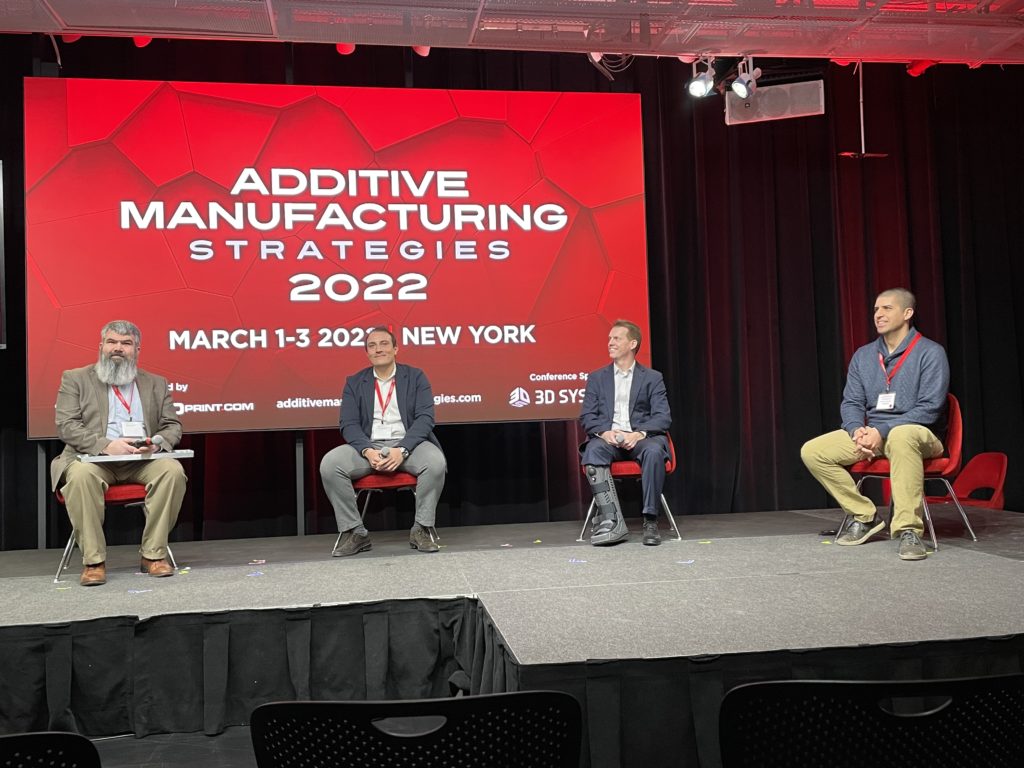
L-R: Mark Norfolk, Fabrisonic; Francesco De Stefano, Caracol; Jason Jones, Hybrid Manufacturing Technologies; Mike Vasquez, 3Degrees
Vasquez wanted to know what gaps their companies were filling in the market, and Jones said it was “people who want finished parts quickly,” explaining that they often add metal to existing parts, which “changes a lot of the economic challenges.” De Stefano says Caracol focuses on fixing cost, lead time, and sustainability, while Norfolk mentioned Fabrisonic’s no-melt technology, which allows for work in applications like embedded electronics and 3D printing tantalum for radiation shielding onto heat exchangers.
Qualification is different when it comes to hybrid technology, as Vasquez noted, and Norfolk said it’s “a spectrum depending on the customer and use case,” and not so driven by the technology itself.
“This morning, someone mentioned the more “cowboy industries,” like EVs, and the qualification for that was, ‘We said it was good enough and handed it over in a box,'” he continued.
Jones explained that with the flexibility of hybrid, you can lean on other qualified manufacturing technologies and just print on the areas you need.
In terms of best practices, Norfolk said the question his team asks about a project is “What’s the best way to make this,” and not how they can make it specifically with Fabrisonic’s technology. Jones said the industry needs to get past the notion that “super-specialized people” are the only ones who can run the equipment.
“The closer we can get it to playing a video game, the closer we get to the next generation being able to use it,” he continued.
Vasquez asked what they were most excited about in the near future, and Norfolk said Fabrisonic looks to “realizing all the dreams we’re seeing today,” as customers often come to them with “crazy prototype ideas.” Jones and De Stefano agreed that they were excited about the convergence of different manufacturing processes.
Emerging Markets for Large AM Parts
Tyler Benster, General Partner at Asimov Ventures, returned to moderate the track’s last panel, Emerging Markets for Large AM Parts, and was joined onstage by VELO3D’s Murphree, while the rest of the panelists were virtual—Steve Freitas, R&D Director, IMI Critical; Bože Radan, Lead Design Engineer, Velum Nautica; and Dan Braley, Boeing Associate Technical Fellow and the Boeing Global Services Additive Manufacturing Technical Focal & Initiatives Leader.
First off, Benster asked why we’re starting to see major adoption of large-scale AM, and Murphree said the addition of throughput makes it “more commercially viable.” Radan explained that large-scale AM makes it possible to create parts that are always the same and “shorten the final product for custom, large parts.” Coming from the Boeing perspective, Braley said the need for repairs is large because “customers fly their aircraft platforms much longer than was every designed for or expected,” and those platforms aren’t in production anymore, meaning the suppliers may not exist either.
Benster asked about unexpected hurdles in developing large-scale AM equipment, and Braley said they have to prove that the properties scale. Murphree said people aren’t always prepared for how big things can get when scaling with a laser powder bed platform, from consumables to facility size. Freitas said there are plenty of potential risks, including failed prints, which can be a major time loss and very expensive as well. This led Benster to ask how important in-process print monitoring is, and Freitas praised the “impressive” level of detail in diagnostics, but said that you have to be able to present the information to your customer and get them to understand and fix any issues.

Top row, L-R: Dan Braley, Boeing, and Bože Radan, Velum Nautica; Bottom row: Steve Freitas, IMI Critical
Radan and Murphree both said it matters more what you do before you start the print, instead of relying on in-process print monitoring. Radan said simple mistakes can result in expensive problems, and that you need to measure everything more than twice to be sure you have the exact dimensions before printing. Making sure that the machine is calibrated, according to Murphree, is “the most mundane step you can take, but it’s absolutely critical.”
Stay tuned for my upcoming report on the third metal AM track at AMS 2022, focused on metals and new materials!
Subscribe to Our Email Newsletter
Stay up-to-date on all the latest news from the 3D printing industry and receive information and offers from third party vendors.
You May Also Like
3D Printing Unpeeled: New Arkema Material for HP, Saddle and Macro MEMS
A new Arkema material for MJF is said to reduce costs per part by up to 25% and have an 85% reusability ratio. HP 3D HR PA 12 S has been...
3D Printing News Briefs, January 20, 2024: FDM, LPBF, Underwater 3D Printer, Racing, & More
We’re starting off with a process certification in today’s 3D Printing News Briefs, and then moving on to research about solute trapping, laser powder bed fusion, and then moving on...
3D Printing Webinar and Event Roundup: December 3, 2023
We’ve got plenty of events and webinars coming up for you this week! Quickparts is having a Manufacturing Roadshow, America Makes is holding a Member Town Hall, Stratafest makes two...
Formnext 2023 Day Three: Slam Dunk
I’m high—high on trade show. I’ve met numerous new faces and reconnected with old friends, creating an absolutely wonderful atmosphere. The excitement is palpable over several emerging developments. The high...




